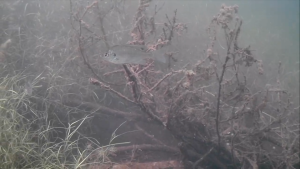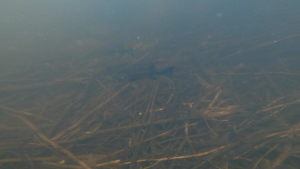by Jonathan Miller, Riparian Habitat Restoration Intern
Freshwater ecosystems such as lakes, rivers, and the smallest of streams are complex environments that support a rich diversity of life. They are home to fish, turtles, macroinvertebrates, and much more. Among the many factors that influence these ecosystems, in-water woody debris plays a large part. In-water woody debris, including fallen trees, branches, roots, and logs, offer habitat benefits for fish, invertebrates, birds, turtles, and many more aquatic organisms. The importance of these natural structures becomes even more apparent when looking at the challenges posed by human activity and climate change on their unique ecosystems.
Human activities and development, in particular, have significantly reduced the amount of natural woody debris in lakes despite their great importance to these environments. Underwater woody debris provides essential habitat for a wide range of wildlife (Roni & Quinn, 2001). This debris is naturally deposited into lakes through various processes such as beaver activity, wind, erosion, and inflows from rivers or creeks (Stringer & Gaywood, 2016; Piegay & Gurnell, 1997). However, as human development begins to alter these landscapes, the availability of woody debris has slowly started to diminish, impacting the overall health and biodiversity of freshwater ecosystems.

Underwater view of a fish using a site where Watersheds Canada has placed a woody debris pile to restore fish habitat.
Communities are capable of helping enhance their wildlife populations by creating additional woody debris habitats, such as in-water brush piles. These structures offer many benefits to the ecosystem, such as providing fish with a reliable food source, shaded areas for resting, safe spaces for spawning and evading predators (Roni & Quinn, 2001). Best of all, they are easy to implement! Additionally, woody debris can create microhabitats that support a range of aquatic macroinvertebrates which are essential prey for small fish and other predators (Benke & Wallace, 2003). Therefore, by incorporating these brush piles into underwater ecosystems, communities can help support the health of their local ecosystems and ensure they continue to thrive in the future. Woody debris also plays a role in supporting fish spawning for many species. Certain fish species, such as pike and yellow perch, utilize this woody debris as a substrate for laying eggs. The debris provides both protection for the eggs and a safe environment that will increase egg survival (Fausch et al., 2002).
Underwater woody debris also offers benefits for other species, including turtles who use semi-aquatic logs as basking sites. In more temperate regions of Canada, species such as the painted turtle rely on exposed woody debris such as logs and branches for thermoregulation (Marchand, 2018). The availability of these habitats is vital to their survival, particularly in freshwater environments that might lack alternative options for basking (Marchand, 2018). It is important to allow these natural elements to enter the lake if you have a waterfront property.
Going beyond the direct habitat benefits, woody debris contributes to the overall health of aquatic ecosystems. Woody debris can change water flow, creating pools and riffles that increase habitat diversity (Piegay & Gurnell, 1997). These features are essential in maintaining the biodiversity of freshwater systems, as different species, especially invertebrates, are adapted to varying flow velocities. Submerged woody debris can also aid in the capture and storage of carbon. It is common for the focus of carbon sequestration to land on terrestrial forests, but aquatic ecosystems have their part to play. Submerged wood can sequestrate carbon for decades to centuries, thereby contributing to the importance of these freshwater ecosystems in combating carbon emissions (Battin et al., 2009).

Two largemouth bass (Micropterus salmoides) utilize a underwater woody debris pile after a Watersheds Canada-led restoration event.
As climate change alters the dynamics and structure of freshwater ecosystems, the role of woody debris becomes even more critical. Climate change is expected to increase the frequency and intensity of weather events. This will lead to a greater input of woody debris into lakes and rivers as a repercussion (Palmer et al., 2009). The sudden influx of large amounts of debris can disrupt aquatic ecosystems, especially in the case of debris accumulation in areas where it blocks fish or alters the flow in ways that could degrade habitat quality (Palmer et al., 2009). To minimize this, management practices, such as those outlined in Watersheds Canada’s In-Water Brush Piles (woody debris) Enhancement protocol, can help ensure that woody debris is placed in ways that increase habitat benefits while having any negative impacts.
To conclude, in-water woody debris is essential to any healthy freshwater ecosystem. These areas provide habitat for fish, macroinvertebrates, turtles, and much more, support ecosystem processes such as carbon sequestration, and offer climate resiliency in the face of climate change events. As humans continue to deal with the challenges posed by climate change, the management and implementation of woody debris in aquatic environments will become increasingly important. Community involvement in these projects is what will lead to higher success.
Watersheds Canada’s website contains further information on the topic if you are interested, volunteer opportunities if you want to get involved, an open call for in-water woody debris projects in Central-Eastern Ontario, many more blogs on similar topics, and the opportunity to support freshwater conservation work directly by making a donation.
References
Battin, T. J., Kaplan, L. A., Findlay, S., Hopkinson, C. S., Marti, E., Packman, A. I., … & Sabater, F. (2009). Biophysical controls on organic carbon fluxes in fluvial networks. Nature Geoscience, 2(8), 595-595.
Benke, A. C., & Wallace, J. B. (2003). Influence of wood on invertebrate communities in streams and rivers. American Fisheries Society Symposium, 37, 149-177.
Fausch, K. D., Torgersen, C. E., Baxter, C. V., & Li, H. W. (2002). Landscapes to Riverscapes: Bridging the Gap between Research and Conservation of Stream Fishes. Bioscience, 52(6), 483–498.
Lanark County Stewardship Council & Watersheds Canada. (2021). In-Water Brush Piles in Ontario. Watersheds Canada. https://watersheds.ca/our-work-resources
Marchand, K. A., Poulin, R. G., & Somers, C. M. (2018). Western Painted Turtles (Chrysemys picta bellii) in a Highly Urbanized System: Unexpected Variation in Resource Use Among Age Classes and Sexes. Herpetologica, 74(3), 217–225.
Palmer, M. A., Lettenmaier, D. P., Poff, N. L., Postel, S. L., Richter, B., & Warner, R. (2009). Climate Change and River Ecosystems: Protection and Adaptation Options. Environmental Management (New York), 44(6), 1053–1068.
Piegay, H., & Gurnell, A. M. (1997). Large woody debris and river geomorphological pattern: examples from S.E. France and S. England. Geomorphology, 19(1-2), 99-116. doi:10.1016/S0169-555X(96)00045-8
Roni, P., & Quinn, T. P. (2001). Density and size of juvenile salmonids in response to placement of large woody debris in western Oregon and Washington streams. Canadian Journal of Fisheries and Aquatic Sciences, 58(2), 282-292.
Stringer, A. P., & Gaywood, M. J. (2016). The impacts of beavers Castor spp. on biodiversity and the ecological basis for their reintroduction to Scotland, UK. Mammal Review, 46(4), 270–283.
This blog post is part of a series generously funding by the Government of Canada’s EcoAction Community Funding Program, and a project delivered in partnership with Crowe Valley Conservation Authority.
